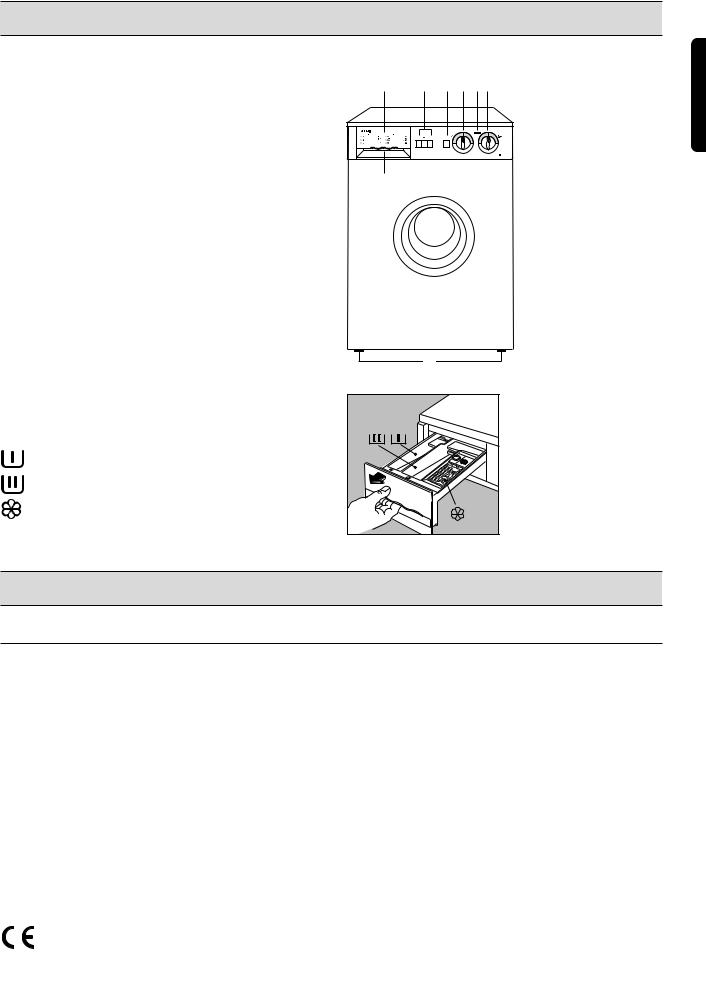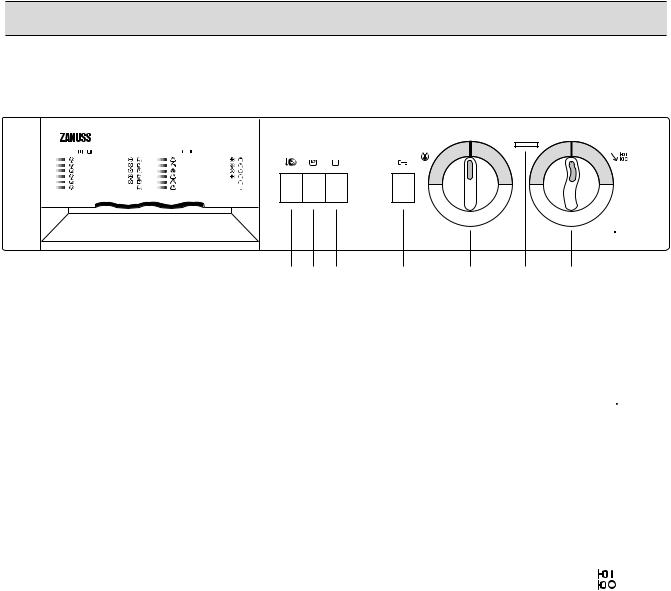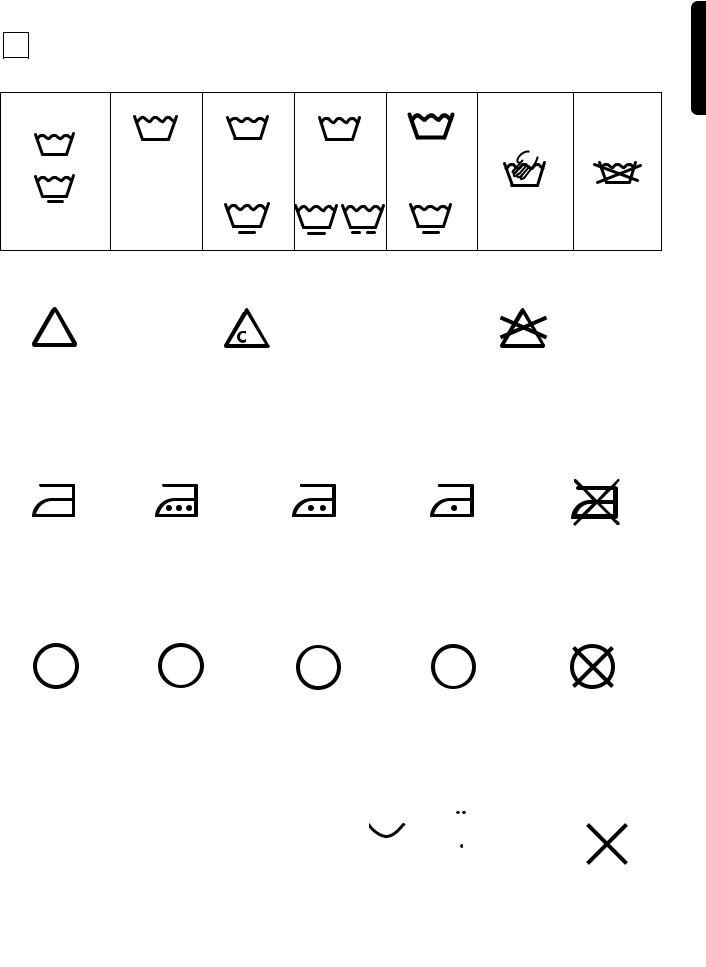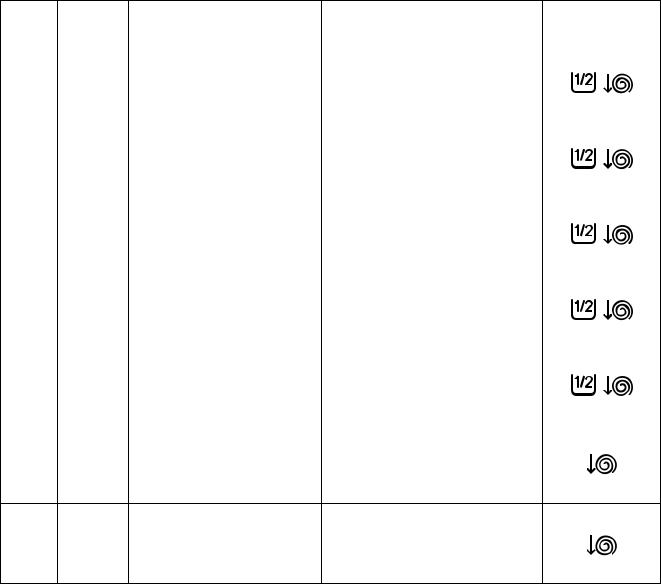Zanussi FL 726 CN User Manual

WASHINGMACHINE
STIRALWNAÅ MAfiINA
FL726CN
INSTRUCTION BOOKLET
124972370 |
RUKOVODSTVO PO ÈKSPLUATACII |

YOUR NEW WASHING MACHINE
This new washing machine meets all requirements for a modern washing of laundry with reduced consumption of water, energy and detergent.
■The temperature selector dial allows you to choose personally the suitable washing temperature for your laundry.
■The automatic cooling of the washing water from 95°C to 60°C before draining will prevent plastic pipes of your drainage system from being deformed.
■The anti-unbalance device ensures that the washing machine remains stable when spinning.
 Ecological hints
Ecological hints
In order to obtain water and energy savings and to protect the environment, we advice you to follow these instructions:
■Whenever possible, wash the maximum load for the selected programme, without overloading the drum.
■Use a programme with prewash only for heavy soiled items.
■Measure out detergent according to the water hardness, degree of soiling and quantity of laundry being washed.
■Select “Quick wash” for lightly soiled laundry.
 Environment protection
Environment protection
■ Packaging recycling
Materials marked with the 
 symbol are recyclable. To enable them to be recycled, they must be placed in the appropriate collection areas (or containers). Check with your local authorities.
symbol are recyclable. To enable them to be recycled, they must be placed in the appropriate collection areas (or containers). Check with your local authorities.
>PE<= polyethylene >PS<= polystyrene >PP<= polypropylene
■ Washing machine scrapping
When the appliance is to be scrapped, cut off the power supply cable and make the door closing device inoperative to avoid it becoming a death trap for a child.
For correct disposal of the machine, contact your local authority department which provides for collection of urban solid refuse.
The symbols you will see on some paragraphs of this booklet have the following meaning:
Important information concerning the safety in the use of your machine. Disregarding this information might lead to damages.
Information for correct use of your i machine and to obtain the best
performance.
Important information concerning environment protection.
Our contribution to the protection of the environment: we use recycled paper.
2

CONTENTS
Important information . . . . . . . . . . . . .4
Description of the appliance . . |
. . . .5 |
|
■ |
Detergent dispenser drawer |
|
|
and programme chart . . . . . . . . . . . . . |
. . . .5 |
Technical specifications . . . . . . . |
. . . .5 |
|
Installation . . . . . . . . . . . . . . . . . . . . |
. . . .6 |
|
■ |
Unpacking . . . . . . . . . . . . . . . . . . . . . . |
. . . .6 |
■ |
Positioning . . . . . . . . . . . . . . . . . . . . . . |
. . . .6 |
■ |
Water inlet . . . . . . . . . . . . . . . . . . . . . . |
. . . .7 |
■ |
Water drainage . . . . . . . . . . . . . . . . . . |
. . . .7 |
■ |
Electrical connection . . . . . . . . . . . . . . |
. . . .7 |
Use . . . . . . . . . . . . . . . . . . . . . . . . . . . . . |
. . . .8 |
|
■ |
Control panel . . . . . . . . . . . . . . . . . . . |
. . . .8 |
■ |
Washing hints . . . . . . . . . . . . . . . . . . . |
. . . .9 |
|
Sorting the laundry . . . . . . . . . . . . . . . |
. . . .9 |
|
Temperatures . . . . . . . . . . . . . . . . . . . . |
. . . .9 |
|
Before loading the laundry . . . . . . . . . . |
. . . .9 |
|
Maximum loads . . . . . . . . . . . . . . . . . . |
. . . .9 |
|
Laundry weights . . . . . . . . . . . . . . . . . . |
. . . .9 |
|
Removing stains . . . . . . . . . . . . . . . . . |
. . . .9 |
|
Detergents and additives . . . . . . . . . . . |
. . .10 |
|
Quantity of detergent to be used . . . . . |
. . .10 |
■ |
International wash code symbols . . . . . |
. . .11 |
■ |
Washing programmes . . . . . . . . . . . . . . |
12-13 |
■ |
Operating sequence . . . . . . . . . . . . . . . |
14-15 |
Maintenance . . . . . . . . . . . . . . . . . . . |
. . .16 |
|
■ |
Bodywork . . . . . . . . . . . . . . . . . . . . . . . |
. . .16 |
■ |
Detergent dispenser drawer . . . . . . . . . |
. . .16 |
■ |
Water inlet filter . . . . . . . . . . . . . . . . . . |
. . .16 |
■ |
Drain pump . . . . . . . . . . . . . . . . . . . . . |
. . .17 |
■ |
The dangers of freezing . . . . . . . . . . . . |
. . .17 |
Something not working . . . . . . . . |
18-19 |
|
3

IMPORTANT INFORMATION
It is important that this instruction book be kept with the appliance for future reference. If you sell or give the appliance away, make sure that the book is passed to the new owners so that they can familiarise themselves with its operation and relevant warnings.
The following warnings are provided in the interests of overall safety. You must read them carefully before installing or using the appliance.
Installation
■When unpacking the appliance, check that it is not damaged. If in doubt, do not use it and contact the Service Centre.
■All internal packing must be removed before using the appliance. Serious damage may be caused to the machine or adjacent furniture if the protective transit devices are not removed or are not completely removed. Refer to the relevant paragraph in the instruction book.
■Any electrical work required to install this appliance must be carried out by a qualified electrician.
■Use only the recommended quantities of fabric softener. An excessive amount could damage the laundry.
■Leave the porthole door slightly ajar when the appliance is not in use. This preserves the door seal and prevents the formation of musty smells.
■Always check that water has emptied out before opening the door. If not, drain the water following the instructions in the instruction book.
■Always unplug the appliance and shut the water tap after use.
■Any plumbing work required to install this appliance must be carried out by a qualified plumber.
■After having installed the machine, check that it is not standing on its electrical supply cable.
■If the appliance is placed on a carpeted floor, ensure that air can circulate freely between the adjustable feet and the floor.
Service/repair
■In the event of a fault, do not attempt to repair the appliance yourself. Repairs carried out by inexperienced persons may cause damage.
■If repairs are needed, contact an authorised service centre and ask for genuine spare parts.
Use
■This appliance is designed for domestic use. It must not be used for purposes other than those for which it was designed.
■Do not overload the appliance. Follow the instructions in the instruction book.
■Only wash fabrics which are designed to be machine washed. Follow the instructions on each garment label.
■Make sure that all pockets are empty. Objects such as coins, safety pins, pins and screws can cause extensive damage.
■Do not machine wash garments saturated with petroleum, methylated spirits, trichlorethylene, etc. If such fluids have been used to remove stains prior to washing, wait until they have completely evaporated from the fabric before placing garments in the appliance.
■Place small items such as socks, belts, etc. in a cloth bag or pillowcase to prevent them getting trapped between the drum and the tub.
4
Safety
■This appliance is designed to be used by adults. Children must not be allowed to touch the controls or play with the product.
■During high temperature wash cycles the glass door becomes very hot. Do not touch it.
■Pets sometimes climb into washing machines. Check the drum before each use.

DESCRIPTION OF THE APPLIANCE
1 |
Detergent dispenser drawer |
2 |
3 4 5 6 7 |
2 |
Programme chart |
|
|
3 |
Option buttons |
|
|
4 |
Door opening button |
|
|
5 |
Temperature selector dial |
|
|
6 |
Operating pilot light |
1 |
|
7Programme selector dial
8Adjustable feet
8
Detergent dispenser drawer and programme chart
Symbols
Prewash
Main wash
Fabric softener
C0006
There is a programme guide in symbols on the handle of the detergent dispenser drawer.
TECHNICAL SPECIFICATIONS
DIMENSIONS |
Height |
85 cm |
|
Width |
60 cm |
|
Depth |
32 cm |
|
|
|
POWER SUPPLY VOLTAGE/FREQUENCY |
220-230V/50 Hz |
|
TOTAL POWER ABSORBED |
|
1750 W |
MINIMUM FUSE PROTECTION |
|
10 A |
|
|
|
WATER PRESSURE |
Minimum |
50 N/cm2 |
|
Maximum |
80 N/cm2 |
|
|
|
MAXIMUM LOAD |
Cotton |
3.0 kg |
|
Synthetics, delicate fabrics |
1.0 kg |
|
Woollens |
0.7 kg |
|
|
|
SPIN SPEED |
|
700 rpm |
|
|
|
This appliance complies with the following EEC Directives: 73/23/EEC of 19/02/73 relating to low voltage
89/336/EEC of 03/05/89 relating to electromagnetic compatibility
5

INSTALLATION
Unpacking
All transit bolts and packing must be removed before using the appliance.
You are advised to keep all transit devices so that they can be refitted if the machine ever has to be transported again.
1.Using a spanner, unscrew and remove the rear right-hand bolt and lay the machine on its back, taking care not to squash the hoses. This can be avoided by placing one of the corner packing pieces between the machine and the floor.
P0255 |
2.Release the two plastic bags by removing the adhesive strip.
3.Carefully remove the right-hand bag (1) then the left-hand bag (2) by pulling them towards the centre of the machine.
4.Set the machine upright and remove the two remaining bolts from the back.
5.Pull out the three plastic spacers from the holes into which the bolts were fitted.
6.Plug the open holes with the plugs which you will find in the plastic bag containing the instruction booklet.
Positioning
Install the machine on a flat hard floor. Make sure that air circulation around the
machine is not impeded by carpets, rugs etc. Check that the machine does not touch the wall or other kitchen units.
Carefully level by screwing the adjustable feet in or out. Never place cardboard, wood or similar materials under the machine to compensate for any unevenness in the floor.
P0648 |
P0256 |
P1051 |
2 |
1 |
P0233 |
|
P0020 |
6

Water inlet
Connect the water inlet hose to a tap with a 3/4" thread after having inserted the small filter “A” supplied with the machine.
The other end of the inlet hose which connects to the machine can be turned in any direction. Simply loosen the fitting, rotate the hose and retighten the fitting, making sure there are no water leaks.
The inlet hose must not be lengthened. If it is too short and you do not wish to move the tap, you will have to purchase a new, longer hose specially designed for this type of use.
Water drainage
The end of the drain hose can be positioned in three ways:
Hooked over the edge of a sink using the plastic hose guide supplied with the machine. In this case, make sure the end cannot come unhooked when the machine is emptying.
This could be done by tying it to the tap with a piece of string or attaching it to the wall.
In a sink drain pipe branch. This branch must be above the trap so that the bend is at least 60 cm above the ground.
Directly into a drain pipe at a height of not less than 60 cm and not more than 90 cm. The end of the drain hose must always be ventilated, i.e. the inside diameter of the drain
pipe must be larger than the outside diameter of the drain hose.
The drain hose must not be kinked. Run it along the floor; only the part near the drainage point must be raised.
A |
P0003 |
P0022 |
P0021 |
P0023 |
Electrical connection
This machine is designed to operate on a 220-230 V, single-phase, 50 Hz supply.
Check that your domestic electrical installation can take the maximum load required (1.75 kW), also taking into account any other appliances in use.
Connect the machine to an earthed socket, in accordance with current wiring regulations.
The manufacturer declines any responsibility for damage or injury through failure to comply with the above safety precaution.
In the event of replacing the electric cable, please contact our nearest Service Centre.
7

USE
Control panel
A B |
|
40º95º |
B30º60º
C30º40º
D F G
H J |
30º60º |
K30º40º
L30º40º
M N P
F L 7 2 6 C N
1 2 3
1 Spin speed reduction button 
By depressing this button the spin speed is reduced from 700 to 500 rpm in the cotton programmes and from 550 to 400 rpm in the gentle programmes.
2 Half-load button 
By depressing this button when washing a small load of cottons or linens (max 1.5 kg) you will obtain a reduction of the water consumption on the rinse cycle.
The machine will carry out 3 rinses instead of 4.
3 Anti-crease button 
By depressing this button on programmes H-J- K-L-M the water of the last rinse is not emptied out, to prevent the fabrics from creasing. To drain the water, depress this button again (the laundry will be gently spun) or select drain programme “P”.
4 |
5 |
6 |
7 |
4 Door opening button 
Depress it to open the door.
5 Temperature selector dial 
Turn this dial to select the washing temperature. Position  = cold wash.
= cold wash.
6 Operating pilot light
This light is on whilst the machine is operating and goes out at the end of the programme.
7 Programme selector dial
To select the required programme, turn this dial clockwise until the programme letter is exactly opposite the pointer.
To start the programme, pull the dial outwards, to switch off the machine, push the dial inwards.
8

i Washing hints
Sorting the laundry
Follow the wash code symbols on each garment label and the manufacturer’s washing instructions.
Sort the laundry as follows:
whites, coloureds, synthetics, delicates, woollens.
Temperatures
95° for normally soiled white cottons and linen (e.g. tea cloths, towels, tablecloths, sheets...)
60° for normally soiled, colour fast garments (e.g. shirts, night dresses, pyjamas....) in linen, cotton or synthetic fibres and for lightly soiled white cotton (e.g. underwear).
 (cold) for delicate items (e.g. net curtains), 30°-40° mixed laundry including synthetic
(cold) for delicate items (e.g. net curtains), 30°-40° mixed laundry including synthetic
fibres and woollens bearing the label «pure new wool, machine washable, non-shrink»
Before loading the laundry
Never wash whites and coloureds together. Whites may lose their “whiteness” in the wash.
New coloured items may run in the first wash; they should therefore be washed separately the first time.
Make sure that no metal objects are left in the laundry (e.g. hair clips, safety pins, pins).
Button up pillowcases, close zip fasteners, hooks and poppers. Tie any belts or long tapes.
Remove persistent stains before washing. Rub particularly soiled areas with a special detergent or detergent paste.
Treat curtains with special care. Remove hooks or tie them up in a bag or net.
Maximum loads
Recommended loads are indicated in the programme charts.
General rules:
cotton, linen: drum full but not too tightly packed
synthetics: drum no more than half full
delicate fabrics and woollens: drum no more than one third full.
Washing a maximum load makes the most efficient use of water and energy.
For heavily soiled laundry, reduce the load size.
Laundry weights
The following weights are indicative:
bathrobe |
1200 g |
napkin |
100 g |
quilt cover |
700 g |
sheet |
500 g |
pillow case |
200 g |
tablecloth |
250 g |
towelling towel |
200 g |
tea cloth |
100 g |
night dress |
200 g |
ladies’ briefs |
100 g |
man’s work shirt |
600 g |
man’s shirt |
200 g |
man’s pyjamas |
500 g |
blouse |
100 g |
men’s underpants |
100 g |
Removing stains
Stubborn stains may not be removed by just water and detergent. It is therefore advisable to treat them prior to washing.
Blood: treat fresh stains with cold water. For dried stains, soak overnight in water with a special detergent then rub in the soap and water.
Oil based paint: moisten with benzine stain remover, lay the garment on a soft cloth and dab the stain; treat several times.
Dried grease stains: moisten with turpentine, lay the garment on a soft surface and dab the stain with the fingertips and a cotton cloth.
Rust: oxalic acid dissolved in hot water or a rust removing product used cold. Be careful with rust stains which are not recent since the cellulose structure will already have been damaged and the fabric tends to hole.
Mould stains: treat with bleach, rinse well (whites and fast coloureds only).
Grass: soap lightly and treat with bleach (whites and fast coloureds only).
Ball point pen and glue: moisten with acetone (*), lay the garment on a soft cloth and dab the stain.
9
Lipstick: moisten with acetone as above, then treat stains with methylated spirits. Remove any residual marks from white fabrics with bleach.
Red wine: soak in water and detergent, rinse and treat with acetic or citric acid, then rinse. Treat any residual marks with bleach.
Ink: depending on the type of ink, moisten the fabric first with acetone (*), then with acetic acid; treat any residual marks on white fabrics with bleach and then rinse thoroughly.
Tar stains: first treat with stain remover, methylated spirits or benzine, then rub with detergent paste.
(*) do not use acetone on artificial silk
Detergents and additives
Good washing results also depend on the choice of detergent and use of the correct quantities to avoid waste and protect the environment. Although biodegradable, detergents contain substances which, in large quantities, can upset the delicate balance of nature.
The choice of detergent will depend on the type of fabric (delicates, woollens, cottons, etc.), the colour, washing temperature and degree of soiling.
All commonly available washing machine detergents may be used in this appliance:
–powder detergents for all types of fabric,
–powder detergents for delicate fabrics (60°C max) and woollens,
–liquid detergents, preferably for low temperature wash programmes (60°C max) for all types of fabric, or special for woollens only.
The detergent and any additives must be placed in the appropriate compartments of the dispenser drawer before starting the wash programme.
If using concentrated powder or liquid detergents, a programme without prewash must be selected.
Pour liquid detergent into the dispenser drawer compartment marked  just before starting the programme.
just before starting the programme.
Any fabric softener or starching additives must be poured into the compartment marked  before starting the wash programme.
before starting the wash programme.
Follow the product manufacturer’s recommendations on quantities to use.
Quantity of detergent to be used
The type and quantity of detergent will depend on the type of fabric, load size, degree of soiling and hardness of the water used.
Water hardness is classified in so-called “degrees” of hardness. Information on hardness of the water in your area can be obtained from the relevant water supply company, or from your local authority.
Follow the product manufacturers’ instructions on quantities to use.
Use less detergent if:
–you are washing a small load
–the laundry is lightly soiled
–large amounts of foam form during washing.
Degrees of water hardness
|
|
|
Degrees |
|
Level |
Characteristic |
|
|
|
|
German |
French |
||
|
|
|
||
|
|
|
°dH |
°T.H. |
|
|
|
|
|
1 |
soft |
00-07 |
00-15 |
|
2 |
medium |
08-14 |
16-25 |
|
3 |
hard |
15-21 |
26-37 |
|
4 |
very hard |
more than 21 |
more than 37 |
|
|
|
|
|
|
10

i International wash code symbols
These symbols appear on fabric labels, in order to help you choose the best way to treat your laundry.
Energetic wash |
|
|
|
30 |
|
95 |
60 |
|
40 |
|
|
Max. wash |
Max. wash |
Max. wash |
Max. wash |
|
|
temperature |
temperature |
temperature |
temperature |
|
|
95°C |
60°C |
|
40°C |
30°C |
|
|
60 |
|
|
Hand wash |
Do not |
Delicate wash |
40 |
40 |
30 |
wash |
|
|
|
|
|
|
at all |
Bleaching |
|
|
|
|
|
|
|
Bleach in cold water |
Do not bleach |
||
|
|
|
|
Ironing |
Hot iron |
Warm iron |
Lukewarm iron |
Do not iron |
|
max 200°C |
max 150°C |
max 110°C |
|
|
|
|
|
|
|
|
|
|
|
A |
|
|
|
|
|
|
|
P |
|
|
|
|
|
F |
|
|
|
|
||||||||
Dry cleaning |
Dry cleaning |
|
|
|
Dry cleaning in |
|
|
|
|
Dry cleaning |
|
Do not |
|||||||||||||||||||
|
|
|
in all solvents |
|
|
|
perchlorethylene, |
|
|
|
|
in petrol, |
|
dry clean |
|||||||||||||||||
|
|
|
|
|
|
|
|
|
|
petrol, pure alcohol, |
|
|
|
|
pure alcohol |
|
|
|
|
||||||||||||
|
|
|
|
|
|
|
|
|
|
|
R 111 & R 113 |
|
|
|
|
and R 113 |
|
|
|
|
|||||||||||
|
|
|
|
|
|
|
|
|
|
|
|
|
|
|
|
|
|
|
|
|
|
|
|
|
|
|
|
|
|
|
|
|
|
|
|
|
|
|
|
|
|
|
|
|
|
|
|
|
|
|
|
|
|
|
|
|
|
|
|
|
|
|
|
|
|
|
|
|
|
|
|
|
|
|
|
|
|
|
|
|
|
|
|
|
|
|
|
|
|
|
high |
|
|
|
|
|
|
|
|
|
|
|
|
|
|
|
|
|
|
|
|
|
|
|
|
|
|
|
|
|
|
|
|
|
|||
|
|
|
|
|
|
|
|
|
|
|
|
|
|
|
|
|
|
|
|
|
|
|
|
|
|
|
temperature |
|
|
|
|
|
|
|
|
|
|
|
|
|
|
|
|
|
|
|
|
|
|
|
|
|
|
|
|
|
|
|
|||||
|
|
|
|
|
|
|
|
|
|
|
|
|
|
|
|
|
|
|
|
|
|
|
|
|
|
|
low |
|
|
|
|
|
|
|
|
|
|
|
|
|
|
|
|
|
|
|
|
|
|
|
|
|
|
|
|
|
|
|
|
|
|
||
|
|
|
|
|
|
|
|
|
|
|
|
|
|
|
|
|
|
|
|
|
|
|
|
|
|
|
temperature |
|
|
|
|
|
|
|
|
|
|
|
|
|
|
|
|
|
|
|
|
|
|
|
|
|
|
|
|
|
|
|
|||||
Drying |
|
Flat |
On the line |
|
On clothes |
|
|
Tumble dry |
Do not |
||||||||||||||||||||||
|
|
|
|
|
|
|
|
|
|
|
|
|
|
|
|
hanger |
|
|
|
|
|
|
tumble dry |
||||||||
|
|
|
|
|
|
|
|
|
|
|
|
|
|
|
|
|
|
|
|
|
|
|
|
|
|
|
|
|
|
|
|
11

Energetic programmes for cotton and linen 
Maximum load: 3 kg
Progr. |
Temp. |
Type of laundry |
Cycle description |
Possible |
|
options |
|||||
|
|
|
|
||
|
|
|
|
|
|
|
|
Whites |
Prewash |
|
|
A |
40°-95° |
Wash at 40°-95°C |
|
||
with prewash |
|
||||
4 rinses |
|
||||
|
|
(heavy soiled) |
Long spin |
|
|
|
|
|
|
||
|
|
|
|
|
|
B |
40°-95° |
Whites |
Wash at 40°-95°C |
|
|
without prewash |
4 rinses |
|
|||
|
|
(normally soiled) |
Long spin |
|
|
|
|
|
|
|
|
B |
30°-60° |
Coloureds |
Wash at 30°-60°C |
|
|
without prewash |
4 rinses |
|
|||
|
|
(normally soiled) |
Long spin |
|
|
|
|
|
|
|
|
C |
30°-40° |
Quick wash |
Wash at 30°-40°C |
|
|
4 rinses |
|
||||
lightly soiled laundry |
|
||||
|
|
|
Long spin |
|
|
|
|
|
|
|
|
D |
|
|
4 rinses with liquid |
|
|
|
Rinses |
additives, if required |
|
||
|
|
|
Long spin |
|
|
|
|
|
|
|
|
F |
|
|
1 rinse with liquid |
|
|
|
Softener |
additive, if required |
|
||
|
|
|
Long spin |
|
G
Spin |
Drain and long spin |
The temperatures indicated are the optimum temperatures for each programme and depend on the type of laundry and degree of soiling.
12
